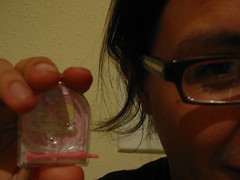Nothingness encapsulated. You won't feel a thing.
Saturday, November 27, 2004
Wednesday, November 24, 2004
Light and day is more than you'll say
Because all
My feelings are more
Than i can let by
Or not
More than you've got
Just follow the day
Follow the day and reach for the sun!
You don't see me flyin to the red
One more you're done
Just follow the seasons and find the time
Reach for the bright side
You don't see me flyin to the red
One more you're nuts
Just follow the day
Follow the day and reach for the sun
Just follow the day
Follow the day and reach for the sun!
Because all
My feelings are more
Than i can let by
Or not
More than you've got
Just follow the day
Follow the day and reach for the sun!
You don't see me flyin to the red
One more you're done
Just follow the seasons and find the time
Reach for the bright side
You don't see me flyin to the red
One more you're nuts
Just follow the day
Follow the day and reach for the sun
Just follow the day
Follow the day and reach for the sun!
Tuesday, November 09, 2004
Geometry is a large subfield of mathematics, but also a label for a certain mindset of a practising mathematician. The same can be told about Algebra (understood here broadly, as the language of mathematics, as opposed to its content, and so including Logic.) A natural or acquired predilection towards geometric or algebraic thinking and respective mental objects is often expressed in strong pronouncements, like Hermann Weyl's exorcising "the devil of abstract algebra" who allegedly struggles with "the angel of geometry" for the soul of each mathematical theory. (One is reminded of an even more sweeping truth: "L'enfer — c'est les autres".)
Actually, the most fascinating thing about algebra and geometry is the way they struggle to help each other to emerge from the chaos of non-being, from those dark depths of subconscious where all roots of intellectual creativity reside. What one "sees" geometrically must be conveyed to others in words and symbols. If the resulting text can never be a perfect vehicle for the private and personal vision, the vision itself can never achieve maturity without being subject to the test of written speech. The latter is, after all, the basis of the social existence of mathematics.
A skillful use of the interpretative algebraic language possesses also a definite therapeutic quality. It allows one to fight the obsession which often accompanies contemplation of enigmatic Rorschach's blots of one's imagination.
When a significant new unit of meaning (technically, a mathematical definition or a mathematical fact) emerges from such a struggle, the mathematical community spends some time elaborating all conceivable implications of this discovery. (As an example, imagine the development of the idea of a continuous function, or a Riemannian metric, or a structure sheaf.) Interiorized, these implications prepare new firm ground for further flights of imagination, and more often than not reveal the limitations of the initial formalization of the geometric intuition. Gradually the discrepancy between the limited scope of this unit of meaning and our newly educated and enhanced geometric vision becomes glaring, and the cycle repeats itself.
Actually, the most fascinating thing about algebra and geometry is the way they struggle to help each other to emerge from the chaos of non-being, from those dark depths of subconscious where all roots of intellectual creativity reside. What one "sees" geometrically must be conveyed to others in words and symbols. If the resulting text can never be a perfect vehicle for the private and personal vision, the vision itself can never achieve maturity without being subject to the test of written speech. The latter is, after all, the basis of the social existence of mathematics.
A skillful use of the interpretative algebraic language possesses also a definite therapeutic quality. It allows one to fight the obsession which often accompanies contemplation of enigmatic Rorschach's blots of one's imagination.
When a significant new unit of meaning (technically, a mathematical definition or a mathematical fact) emerges from such a struggle, the mathematical community spends some time elaborating all conceivable implications of this discovery. (As an example, imagine the development of the idea of a continuous function, or a Riemannian metric, or a structure sheaf.) Interiorized, these implications prepare new firm ground for further flights of imagination, and more often than not reveal the limitations of the initial formalization of the geometric intuition. Gradually the discrepancy between the limited scope of this unit of meaning and our newly educated and enhanced geometric vision becomes glaring, and the cycle repeats itself.
Subscribe to:
Posts (Atom)
Blog Archive
- August (2)
- July (3)
- April (1)
- March (2)
- February (1)
- November (4)
- October (1)
- September (2)
- June (1)
- May (3)
- April (4)
- January (1)
- November (8)
- October (2)
- September (1)
- July (3)
- June (2)
- May (4)
- March (2)
- February (8)
- December (2)
- November (3)
- October (5)
- September (9)
- July (2)
- June (2)
- May (1)
- April (1)
